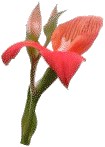
Disa Orchids and Horsemanure as Growing Meduim
Nic had a particular interest in using horse manure with disas and had the following thoughts on it. Some of this is already written in the 'Potting Info' section but this may interest those willing to try it.
The first thing to say is don’t plant disas directly in horse manure. IT DOESN’T WORK.
It will result in feeding the plant with solution that’s too concentrated.
The second thing to say is that if you use the technique described below, using horse manure for disas WORKS BRILLIANTLY giving excellent results.
See results disa photos.
The nutrient requirement for Disa orchids is very low. This can be measured as about 200 micro Siemens. (units of electrical conductivity or E.C.). As a comparison, cymbidiums require
about four times the concentration of nutrients and the E.C. for
those is about 800 micro Siemens.
Horse manure also has a low E.C. but it is still too high for Disa to grow directly in the medium, however great results are achieved with the
method described below.
The E.C. of the solution feeding the plant has to be lower than the E.C. of the plant for the nutrients to be taken up by the plant. The performance of the plant is entirely dependant on this. If it is the opposite, the nutrients will be drawn out of the plant and it dies. This happens when ‘over feeding’ or ‘over fertilizing’.
Outstanding results have been achieved by growers of orchids that require medium to high E.C. solution by using pure fresh horse manure as growing medium. The Nitrogen/Phosphorus/Potassium ratio is about 1.7 – 0.7 – 1.8. The nutrients provided by the manure and the ‘open’ structure of horse manure is ideal to allow air to the roots and free drainage.
Now for disas, the same great results can be achieved if you fill the lower half of the pots with horse manure and the top half with a ‘buffer’ material such as sphagnum moss. Put the plant into the sphagnum moss so that it is above the top of the horse manure level and then it will control it’s own nutrient uptake by putting roots down into the horse manure as required but not more.
Very frequent watering is just as important in getting results from horse manure. Make sure that the manure is permanently very wet. Water every day until the pot starts to drip and make sure it can drip off the bottom of the pot. i.e. don’t stand the pot in anything that can collect water. If you water every second day, that raises the concentration of the nutrients taken by the water from the horse manure to the plant and that is to be avoided.
Understanding the transfer of nutrients from the horse manure to the plant is the ‘secret’ to success with horse manure. The fermenting process starts while it’s still in the horse and the transfer of nutrients from the material to the solution it is in, continues to provide nutrient solution while in the pot. It must be realized that if less water is used, the nutrient concentration of the water available to the roots is higher and with disas this is bad news. So WATER EVERY DAY!
The horse works well to provide this great material. It has a perfectly balanced NPK ratio plus all the trace elements that transfer to the plant via the water every day. The plant does the rest and when planted in a ‘buffer’ as described above it controls the intake perfectly.
When I had my first disa, I put it in a 5cm x 10cm deep pot as described with horse manure in the bottom half and sphagnum in the top half, planting the disa in the sphagnum only.
A couple of weeks later I had visitors from Western Australia interested in cymbidiums in horse manure, and I also showed them the disa. I lifted the sphagnum and there were no roots in the horse manure yet but there was a mass of roots with white ‘hairs’ in the moss. The roots had grown fast but not yet into the manure.
A few weeks later the roots went down into the horse manure and the plant made plenty of stolons.
The plant died after flowering. After I pulled the dead plant out the stolons flowered in the same pot the next year in the same horse manure without a buffer. The horsemanure had decomposed enough by then.
I leave it to the horse to make it, and I leave it to the plant to take it!
I make sure that my plants are dry before nightfall (roots should be wet all the time) and have never had to spray against fungi.
Pests and Diseases.
I have installed a dual speaker pest repeller to discourage rodents and
insects. My area is 450 sq m. It seems that they are working for me as I used to have a bit of rat trouble but not now. Aphids also appeared sometimes but not in the last few years since the gadgets were installed. I feed snails and slugs with snail pellets.